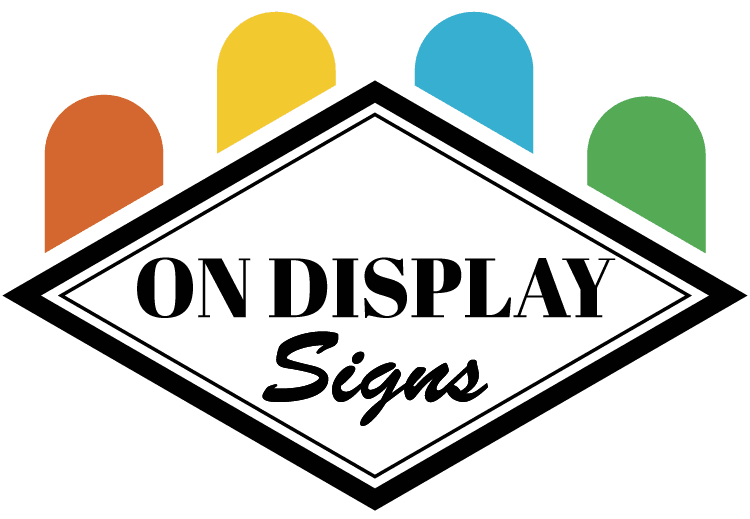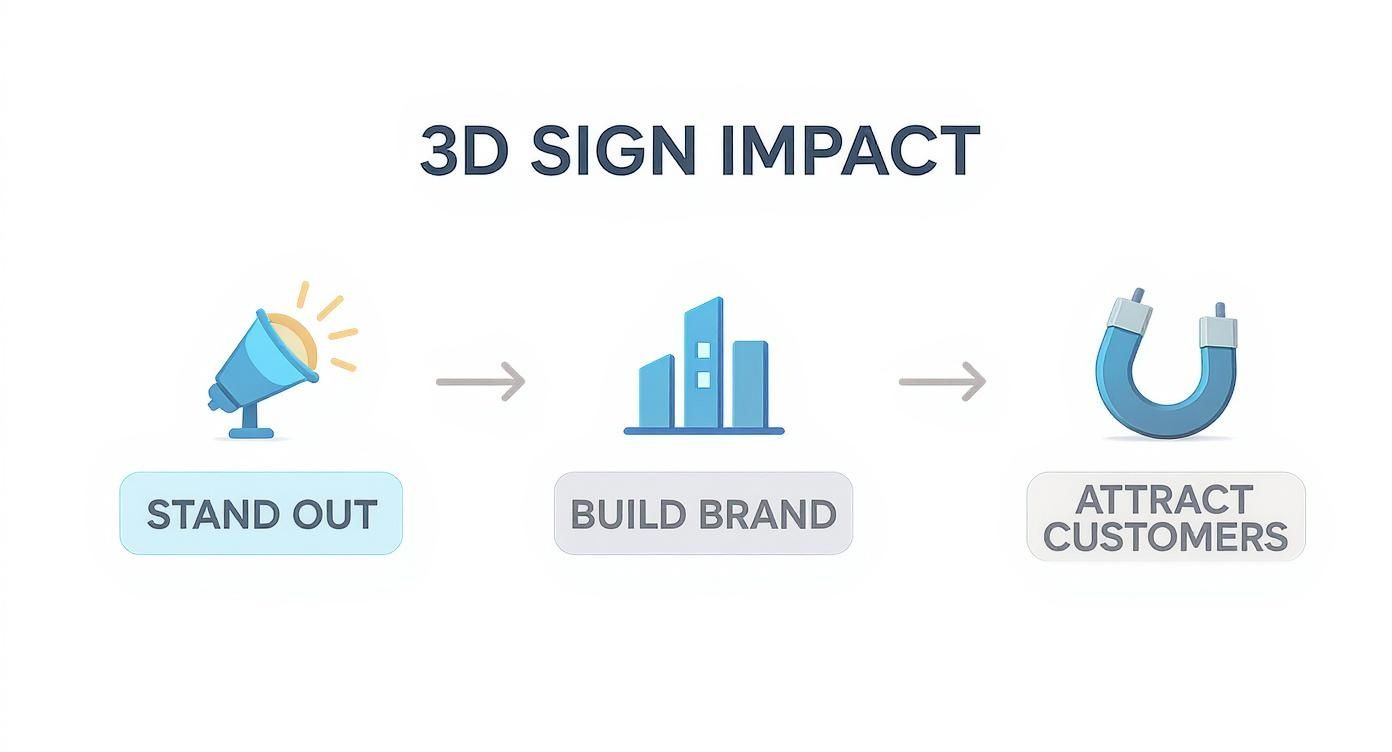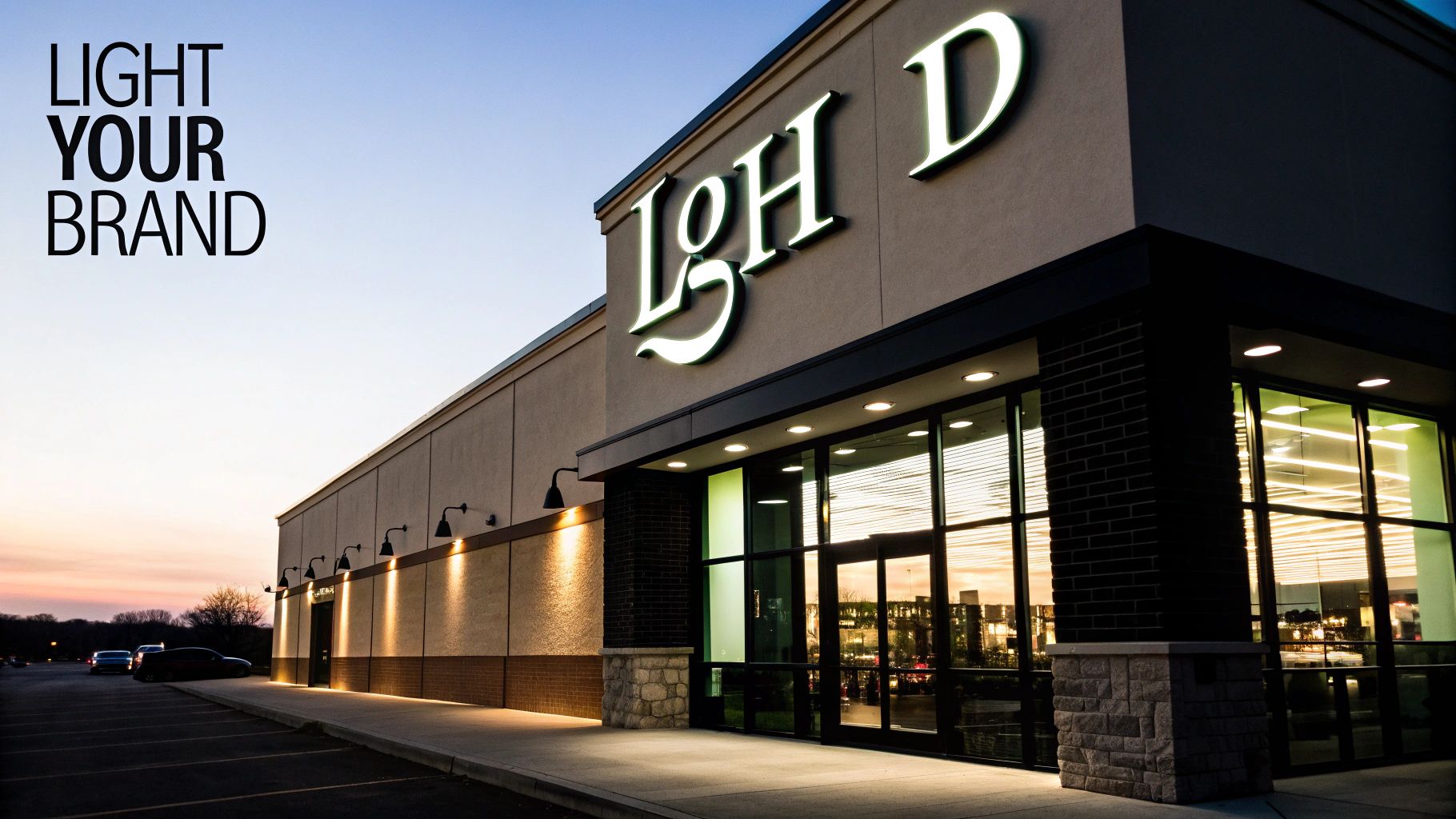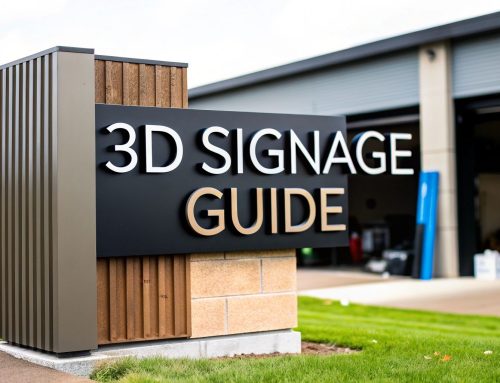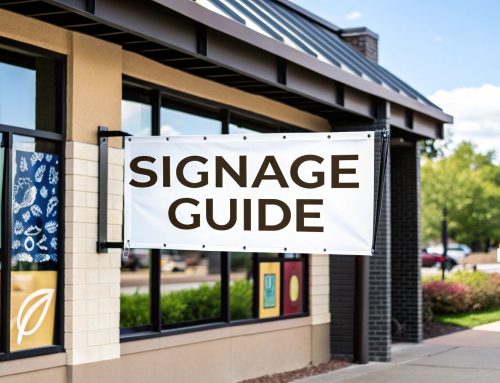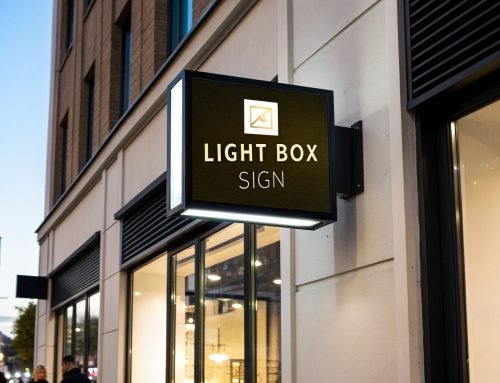A flat sign is like a whisper—easy to miss on a busy street. But a 3d letter sign is a confident voice that cuts through the noise. It does more than just display your name; it builds your brand’s character and signals quality before anyone even walks through your door.
Why a 3D Letter Sign Is Your Strongest First Impression
Think about the difference between a flimsy paper business card and one made from thick, embossed cardstock. You instantly feel the quality of the second one. A 3D letter sign does the same thing for your building, acting as a powerful, physical statement of your brand’s credibility. For example, a law firm with a brushed bronze 3D sign immediately communicates stability and prestige, while a flat vinyl banner might suggest a temporary or less established practice.
This single investment immediately makes your business feel more established and professional. The depth of the letters creates natural shadows, giving your sign a sense of permanence and success. It tells passersby that you’re here to stay and you’re serious about what you do, helping you stand out from competitors with less impressive, flat signage.
Turning Passersby into Visitors
A great 3D letter sign doesn't just identify your business; it actively pulls people in. Its physical presence is interesting and memorable, making your location a landmark in its own right. This is a game-changer for any business that relies on foot traffic. A boutique with a uniquely designed, halo-lit 3D sign becomes a visual marker on the street, making it easy for customers to say, "I'll meet you at the shop with the cool glowing sign."
The industry data backs this up. The demand for dimensional signage is growing fast as more businesses see how powerful it is for creating a strong visual identity. The global sign market, valued at around $118.92 billion in 2025, shows this trend clearly, with 3D letters driving a huge chunk of that growth.
In short, a 3D letter sign transforms your storefront from a simple entrance into a compelling brand statement. It’s an investment in visibility that works for you 24/7, turning curious glances into real customers.
Ultimately, choosing the right signage for commercial buildings is a critical marketing move. A 3D sign ensures your first impression isn't just seen, but felt, setting a positive tone for every customer interaction that follows.
Decoding the Different Types of 3D Letter Signs
Picking the right 3D letter sign is like choosing the voice for your brand. While you've got plenty of options, they really boil down to a few key categories, each with its own personality. Getting familiar with these main types is the first step to finding a sign that feels like it was made just for you.
The whole point is to match the sign’s character to your brand’s. A sleek tech company needs a completely different look than a classic downtown law firm, and the right 3D sign nails that vibe perfectly. For example, a modern tech startup might choose sharp, glossy acrylic letters, while a historic inn would benefit from the timeless look of fabricated brass.
The Industry Standard: Channel Letters
When you picture a classic storefront sign, you're probably thinking of channel letters. These are individual, hollow letters usually built from aluminum with a colorful acrylic face. That hollow construction is their secret weapon, because it lets us pack them with LEDs for brilliant internal lighting that pops day and night.
This is why you see them everywhere—from retail stores to restaurants. They’re the go-to choice for any business on a busy street that needs to stay visible long after the sun goes down. A diner, for instance, uses bright red channel letters to create a welcoming, vibrant beacon for hungry patrons at night. They deliver a clean, professional look that just plain works.
This chart breaks down how a great sign is more than just a name—it’s a magnet for your brand.
It’s not about one single element, but how visibility, branding, and customer attraction all work together to make a real impact.
The Premium Choice: Fabricated Metal Letters
If you want your sign to radiate a sense of permanence and authority, look no further than fabricated metal letters. These aren't hollow like channel letters; they're solid, substantial pieces made from materials like brushed aluminum or polished stainless steel. They have a weight and quality that feels both timeless and high-end.
You'll spot these on corporate headquarters, luxury boutiques, and professional firms that want to project stability and class. A financial advisory firm, for example, might use fabricated stainless steel letters to convey trust and long-term stability to potential clients. While they can be backlit to create an elegant halo glow, their real power comes from their impressive daytime presence.
A fabricated metal sign makes a quiet but powerful statement. It tells the world your brand is built to last, creating an immediate sense of trust and prestige.
The Versatile Option: Plastic and Acrylic Letters
For a modern pop of color and endless design freedom, plastic and acrylic letters are a fantastic choice. These signs are lightweight, tough, and can be cut with laser precision into any font or logo you can dream up. This flexibility makes them a favorite for indoor applications, especially in lobbies and reception areas.
Their clean, often glossy finish is perfect for startups, creative studios, and retail spaces aiming for a contemporary feel. A new gym might use bold, colorful acrylic letters in its reception area to create an energetic and modern atmosphere. While not as common for main outdoor illuminated signs, they are unbeatable for carrying your brand identity throughout your interior space. You can dive deeper into these and other options in our guide to the different types of outdoor business signs, where we explore how each style plays a role in creating a strong brand presence.
Comparing 3D Letter Sign Options
To help you visualize which option might be the best fit, here's a quick comparison of the most common 3D letter sign types. Think about your brand's personality, your location, and your budget as you look through the table.
| Sign Type | Common Materials | Best For | Typical Cost | Illumination |
|---|---|---|---|---|
| Channel Letters | Aluminum, Acrylic | Retail storefronts, restaurants, high-visibility locations | $$ – $$$ | Front-lit, Halo-lit, Combination |
| Fabricated Metal | Stainless Steel, Aluminum, Brass | Corporate HQs, law firms, luxury brands | $$$ – $$$$ | Halo-lit, Non-illuminated |
| Plastic & Acrylic | Formed Plastic, Acrylic | Interior lobbies, reception areas, modern retail | $ – $$ | Non-illuminated, Edge-lit |
Each of these signs has a distinct role to play. The right choice depends entirely on the story you want your physical space to tell.
Bringing Your Brand to Light Day and Night
An unlit sign gets the job done when the sun is out, but an illuminated 3d letter sign works around the clock to capture attention. Think of modern LED lighting as the key that turns your sign from a simple marker into a 24/7 brand beacon, making sure you’re seen long after neighboring businesses have faded into the dark.
This constant visibility isn’t just a nice-to-have; it's a real strategic advantage. The explosion in popularity of 3D letter signs is directly tied to huge leaps in LED technology, which has completely changed how businesses think about advertising. It's no surprise that by 2025, the global digital signage market is expected to rocket to $31.8 billion, with LED-based signs driving a massive part of that growth.
Finding Your Perfect Glow
Choosing how to light your sign is about more than just visibility—it’s about setting the mood for your entire brand. There are a few go-to styles, and each one creates a totally distinct effect.
- Front-Lit Signs: Imagine a classic movie theater marquee. These signs blast light forward through the face of the letters, giving you maximum brightness and readability. This is the perfect choice for a retail store or a restaurant on a busy street that needs to shout its presence from a distance. A 24-hour pharmacy, for example, relies on a bright, front-lit sign to be easily spotted at any time of night.
- Back-Lit (Halo) Signs: This style creates a much more subtle and elegant feel. LEDs are placed inside the letters to cast a soft glow onto the wall behind them. The result is a sophisticated "halo" that outlines your sign—ideal for upscale boutiques, hotels, or corporate offices looking to project a premium, high-end image. An upscale spa might use this to create a tranquil, inviting ambiance before a client even enters.
Smart Lighting for a Smart Investment
Beyond just looking good, today's LED technology offers some major practical perks. LEDs are incredibly energy-efficient, using a tiny fraction of the power needed for old-school neon or fluorescent bulbs. That translates directly into lower monthly utility bills, making an illuminated sign a far more affordable long-term investment.
A properly illuminated sign doesn’t just make you visible; it defines your brand’s atmosphere. The soft glow of a halo sign can feel exclusive and high-end, while the bright pop of a front-lit sign feels energetic and welcoming.
When you're ready to light up your 3D letter sign, understanding the ins and outs of a professional LED lighting installation is the key to making sure your brand shines brightly and efficiently. Getting it done right guarantees safety, longevity, and the best performance for your investment. It’s a critical piece of any effective digital and LED sign strategy.
Choosing Materials That Tell Your Brand Story
The material you pick for your 3D letter sign is way more than a practical choice—it’s a huge part of your brand’s voice. Think about it: a high-end restaurant uses heavy silverware and thick linen napkins to send a message of quality. Your sign’s material does the same thing, communicating a specific feeling before a customer ever steps inside.
Getting this right ensures the physical presence of your sign matches the personality of your brand. A rustic farm-to-table restaurant might choose a sign with a weathered copper finish, while a cutting-edge software company would opt for sleek, brushed aluminum.
This push for unique branding is a massive trend right now. Businesses are ditching cookie-cutter solutions to create memorable experiences, and that starts with their signage. In fact, the global custom signage market is projected to grow at a CAGR of 3.8% from 2022 to 2030, all driven by this need to stand out from the crowd. You can dig deeper into how the signage industry is changing over on Excelkc.com.
Aluminum: The Reliable Workhorse
Think of aluminum as the go-to, versatile foundation for countless signs. It’s strong but surprisingly light, which makes installation much simpler and puts less strain on your building’s facade. Its biggest advantage is just how easily it can be shaped and customized.
Aluminum is usually painted, opening up a nearly infinite color palette to perfectly nail your brand guidelines. For a smart, cost-effective option, you can also look into our aluminum composite signage, which gives you that same durability with a sleek, professional finish. For instance, a coffee shop can use painted aluminum to perfectly match the unique green of its logo, reinforcing its brand identity.
Stainless Steel: The Premium Statement
If your brand needs to scream quality, permanence, and modern elegance, stainless steel is the only way to go. It’s incredibly tough and naturally fights off rust and corrosion, making it a fantastic long-term investment, especially if your sign will be battling the elements.
The finish you choose—from a polished mirror shine to a subtle brushed texture—can completely transform the sign’s personality. A polished finish feels bold and luxurious, while a brushed look offers a more understated, sophisticated vibe. A high-end jeweler might choose a polished finish to mimic the sparkle of their products, whereas a corporate headquarters might select a brushed finish for a more subtle statement of power.
Acrylic: The Modern Chameleon
Acrylic is the perfect material when you’re after a clean, glossy, and contemporary look. It comes in a whole spectrum of vibrant colors and can be laser-cut with incredible precision, creating crisp, sharp logos and letters.
This makes it a huge favorite for indoor branding, like lobby signs and reception displays. Its polished surface adds a touch of modern sleekness that’s perfect for tech companies, creative agencies, and retail shops aiming for a fresh, energetic statement. For example, a marketing agency might use layered, multi-colored acrylic letters in its lobby to showcase its creativity and dynamic approach. Each material tells a different story—your job is to pick the one that speaks for your brand.
From Design to Installation A Smooth Process
A brilliant idea for a 3D letter sign is just the starting line. The real magic happens when that concept is brought to life, moving from a design file on a screen to a physical, show-stopping sign on your building. This journey bridges creative vision with technical know-how to make sure the final result is both stunning and structurally sound.
It all starts with the design, where the little things make a huge difference. Your font choice, for instance, has to be readable from a distance to do its job. A script font might look great up close but become an unreadable blur from across the street. Likewise, your color palette needs to create a bold contrast against your building’s facade, making your sign pop and command attention. While not essential, understanding different manufacturing models like OEM and ODM can give you a better appreciation for how your sign comes to life.
Choosing Your Mounting Method
Once the design is locked in, the next big question is how to attach it to the wall. This decision impacts not just the sign's final look but also how complex the installation will be. There are two main approaches, each with its own pros and cons.
- Raceway Mounting: This is an incredibly practical choice, especially for illuminated signs. The letters are mounted on a slim, rectangular box called a raceway, which neatly contains all the wiring and electrical guts. The whole unit is then mounted to the building, which means fewer holes drilled into your wall and a much simpler installation. This is a great solution for strip malls where landlords may limit the number of penetrations into the building facade.
- Direct-to-Wall Mounting: If you're going for a clean, high-end look, this is the way to go. Also called flush mounting, this method attaches each letter directly to the building's surface. All the wiring and hardware are hidden, creating a seamless, "floating" appearance. It delivers a premium aesthetic but requires a more involved installation process. This method is often chosen for historic buildings to minimize the visual impact on the architecture.
Knowing the difference between these mounting options helps you have a much more productive conversation with your sign company. You can weigh the look you want against the practical realities of your building's structure.
Getting this process right hinges on working with an experienced team. When you partner with pros, they handle all the technical details, making sure your vision becomes a reality without a hitch. If you’re searching for a team to guide your project, checking out the top channel letter sign companies near me is a great place to start.
Navigating Budgets, Permits, and Maintenance
Getting a 3D letter sign on your wall involves a lot more than just picking a cool design. You have to think about the real-world stuff: the budget, the local rules, and how you'll keep it looking great. Getting these details right from the start is the difference between a smooth project and a major headache.
When it comes to cost, the biggest factors are pretty intuitive: size, materials, and lighting. A massive, halo-lit stainless steel sign for a high-rise is obviously going to be a bigger investment than a simple, non-lit set of acrylic letters for your lobby. To get a clear picture, request detailed quotes that break down the costs for materials, fabrication, lighting components, and installation separately.
Don't Skip the Sign Permitting Process
Before a single hole is drilled, almost every outdoor sign needs a thumbs-up from your local city or county. This means submitting detailed plans to prove your sign meets all the local codes for things like zoning, safety, and size. Honestly, trying to handle this on your own can be a tangled mess of paperwork and confusing rules.
This is where a good sign partner proves their worth. A professional sign company will handle the entire permitting headache for you—from drawing up the plans to talking with city officials. That service alone can save you from big fines and frustrating delays. They know the local regulations and can often anticipate and resolve potential issues before they cause delays.
Keeping Your Sign Looking Its Best
Once your sign is up, a little TLC goes a long way. Think of it like washing your car; regular maintenance keeps your investment looking sharp and ensures it keeps making a great first impression for your brand.
Here’s a simple checklist to protect your investment:
- Routine Cleaning: A few times a year, give the letters a gentle wipe-down with a soft cloth and a mild cleaner. This gets rid of the dust and grime that can make colors look dull. For example, use a simple solution of water and mild dish soap to clean acrylic faces, and avoid abrasive chemicals.
- Quick Visual Checks: Every so often, just look at your sign. Do you see any flickering lights, loose bits, or obvious wear and tear? Catching these small things early stops them from turning into expensive repairs later on. A monthly walk-around is a great habit to get into.
- An Annual Professional Lookover: It's smart to have a pro inspect your sign once a year, especially after a tough winter or storm season. They'll make sure all the wiring and mounting hardware are still safe and secure. This is a small cost that prevents major issues down the road.
Common Questions About 3D Letter Signs
Even with all the details covered, a few practical questions always come up when you’re getting ready to invest in a 3d letter sign. Here are some straight answers to the questions we hear most often.
How Long Does a 3D Letter Sign Last?
Think of a well-made 3D sign as a permanent fixture for your brand. When you use tough materials like aluminum or stainless steel, you can expect it to last for 15-20 years or more with minimal upkeep. It’s built to handle the weather and look great for a long, long time.
And what about the lights? The high-quality LEDs inside are workhorses. They’re usually rated for 50,000 to 100,000 hours of runtime, meaning you’ll get years of bright, consistent light before a single component needs attention. For a sign lit 12 hours a day, that's over 11 years of continuous operation.
What Is the Difference Between Channel and Fabricated Letters?
It really comes down to how they’re built and how they light up. Channel letters are hollow on the inside, usually with an aluminum body and a translucent acrylic face. This design is all about housing LEDs internally to create that classic, bright, front-lit glow. Think of the bold, colorful signs you see at a bustling shopping center.
Fabricated letters, however, are often made from thick, solid metal. This gives them a heavier, more premium feel. They’re perfect for high-end, non-illuminated signs or for creating that elegant, sophisticated halo-lit effect where the light washes out from behind the letter. This is the style often chosen by exclusive hotels or corporate law firms to create an air of prestige.
Should I Install a 3D Letter Sign Myself?
Please don’t. We strongly advise against any DIY installation, especially for signs that involve electrical wiring. Professional installers are non-negotiable for making sure the sign is anchored securely enough to withstand wind and weather, wiring it safely, and meeting all local building codes.
Hiring a pro isn't just about protecting your new sign; it's about avoiding property damage, ensuring public safety, and making sure the entire permitting process is handled correctly from day one. They have the right equipment, like bucket trucks for high installations, and the expertise to handle unexpected structural challenges. It's the only way to do it right.
Ready to create a sign that makes your brand unforgettable? The team at On Display Signs, Inc. manages every step, from design and permitting to fabrication and installation, ensuring a seamless process and a stunning final product. Explore your options and get started at https://www.ondisplaysigns.com.
